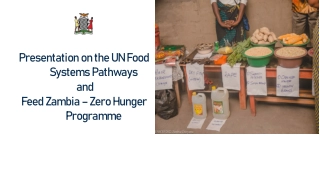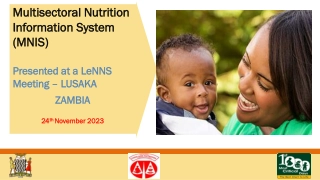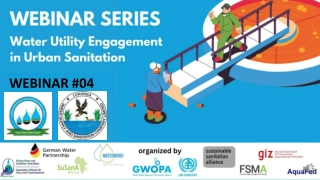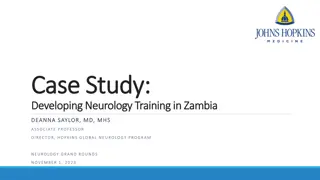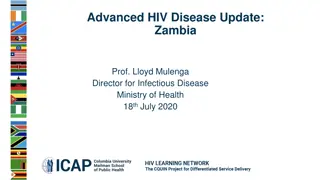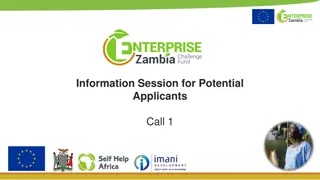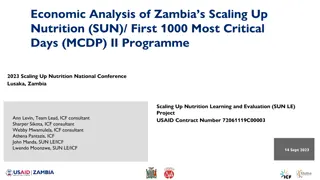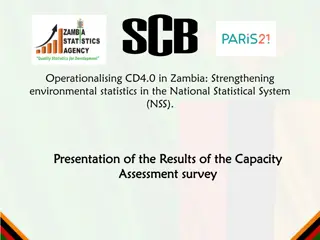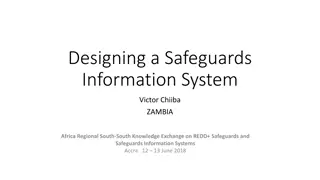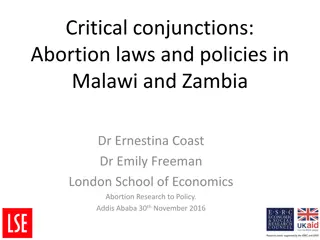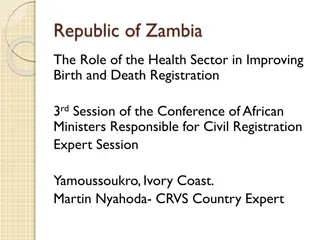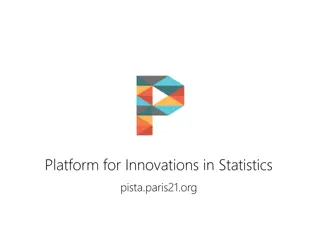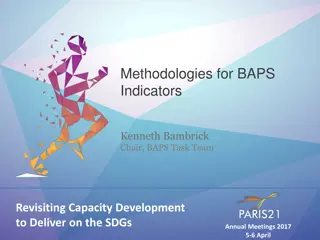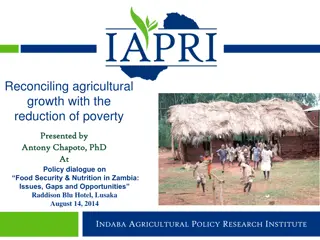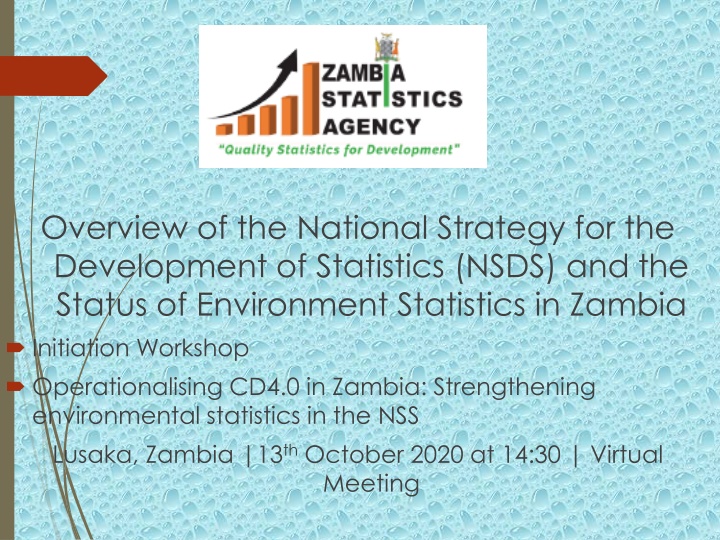
Strengthening Environment Statistics in Zambia: NSDS Overview and Status
This virtual workshop in Lusaka, Zambia focuses on operationalizing CD4.0 by enhancing environmental statistics within the National Statistical System. Learn about the National Strategy for the Development of Statistics (NSDS), the current status of environment statistics in Zambia, data gaps, and the way forward for improving statistical capacity. Explore the evolution of NSDS in Zambia, challenges faced, and the sectoral approach adopted in the successor NSDS2 for 2020-2023.
Download Presentation

Please find below an Image/Link to download the presentation.
The content on the website is provided AS IS for your information and personal use only. It may not be sold, licensed, or shared on other websites without obtaining consent from the author. If you encounter any issues during the download, it is possible that the publisher has removed the file from their server.
You are allowed to download the files provided on this website for personal or commercial use, subject to the condition that they are used lawfully. All files are the property of their respective owners.
The content on the website is provided AS IS for your information and personal use only. It may not be sold, licensed, or shared on other websites without obtaining consent from the author.
E N D
Presentation Transcript
Overview of the National Strategy for the Development of Statistics (NSDS) and the Status of Environment Statistics in Zambia Initiation Workshop Operationalising CD4.0 in Zambia: Strengthening environmental statistics in the NSS Lusaka, Zambia |13thOctober 2020 at 14:30 | Virtual Meeting
OUTLINE Introduction Overview of NSDS in Zambia Description of Environment Statistics Need for Environment Statistics Environment Statistics in Zambia Data collected Data gaps Way Forward
Introduction Government resource to be harnessed for development, particularly in view of the need to measure sector performance and progress in development Development Goals (SDGs). recognises that statistics is an important plans and Sustainable The first NSDS (NSDS1) designed in 2013 and the 7thNational Development Plan (2017-2021) underscored the need for accelerated legal reforms for statistics These reforms are underpinned by the new Statistics Act of 2018 that transformed the Central Statistics Office, then a department in the Ministry, into an autonomous government Statistics Agency with its own governing board.
Introduction contd Over the years, serious data gaps have been observed and experienced in national development planning processes at the stage of determining baselines and targets through compilation of indicators; making difficult the measure of adopted indicators in planning, monitoring and evaluation. Data gaps point to a greater urgency for more and disaggregated data, and for improving the quality and availability of administrative data. There is consensus internationally about the need for a holistic, strategic approach to improving National Statistical Systems and building statistical capacity in developing countries to provide the information needed for managing for results and reporting on development progress.
Overview of NSDS in Zambia Accordingly, design NSDSs as the main framework for addressing national data challenges Zambia developed its first such strategy for the period 2014 to 2018 in 2013. An independent evaluation of this strategy revealed low implementation (56%) of planned activities and thus it did not achieve all its objectives. This was mainly due: Lack of appropriate legal provisions; Lack of resources for the establishment of a coordination mechanism of the National Statistical System. Inadequacy in the strategy design as it was not sector- inclusive. developing countries are expected to
Overview of NSDS in Zambia cont d Therefore, the successor NSDS2 for 2020-2023 has been designed using a sectoral approach & involves Ministries of: Agriculture; Commerce, Trade and Industry; Fisheries and Livestock; Finance; Gender, General Education; Health; and Tourism and Arts. Other institutions are Bank of Zambia; Zambia Revenue Authority and Zambia Statistics Agency.
Overview of NSDS in Zambia cont d This Second National Strategy for the Development of Statistics (NSDS2) for Zambia has been designed at a critical time of: unprecedented increase in demand for development data in terms of quantity, quality and disaggregation; emerging new data ecosystems and non-traditional data sources; emerging partnerships for development data; the data revolution which calls for open data; and new and innovative technologies.
Overview of NSDS in Zambia cont d It was also designed at a time when the Zambia Statistics Agency (ZamStats), the successor to the Central Statistics Office, was getting established government statistics agency. Using a sectoral approach, the selected eleven (11) sectors (government ministries and agencies) undertook an assessment of the state of statistics in each sector and a Sector Statistics Plan (SSP) was designed to address sector-specific data challenges. These SSPs were then used as building blocks for the NSDS2. This approach put into focus administrative data and prioritized their improvement. as an autonomous
Overview of NSDS in Zambia cont d The process of designing the NSDS2 was participatory and inclusive. It involved consultations and engagements with many stakeholders across government, the private sector, civil society sector, research and training institutions and cooperating partners. The purpose was to make the NSDS2 stakeholder- driven by conferring part ownership of NSDS2 on stakeholders and mobilizing implementation. The sectoral approach being scalable, more sectors will be added as capacity is built up and experience gained. them to support its
Description of Environment Statistics cont d They describe the qualitative and quantitative aspects of the state and changes of the environment and its interaction with human activities and natural events. They are integrative, measure human activities and natural events that affect the environment, monitor the impacts on the environment and the social responses to environmental impacts. It is a domain of statistics, and it is indispensable for evidence based policies and decision making to support sustainable development.
Description of Environment Statistics cont d Environment Statistics is multi-disciplinary in nature Covers a wide range of topics Collected from different different methods To effectively produce Statistics, a number of things must be in place Specific statistical and environmental expertise Institutional development capacities Adequate resources sectors using Environment
Need for Environment Statistics Data from compendia and databases can be used to feed into the production sustainable development accounts, at the national and international level Support evidence based policy making Strengthen assessment through quantitative metrics, making analysis and assessment more robust through official, comparable and timely data provision; Enable statistical reporting both at national and international level for environmental agreements, global and regional data collection through Questionnaires instruments). environmental reports, indicators of and and example international and other
Environment Statistics in Zambia There are different ways to structure and organize the contents of Environment Statistics and the most recommended for developing Framework for Development Statistics (FDES) because it is easy and flexible. countries of is the Environment The FDES was implemented in Zambia in 2015. Before environment statistics because of lack of a guideline. then it was a challenge to compile
Environment Statistics in Zambia The FDES, uses a multi sectoral approach to bring together stakeholders who are data providers in Environment Statistics. Data was submitted according to the FDES guidelines. This culminated in the first ever Compendium of Environment Statistics report being produced.
Data collected contd Data collected is in accordance with the Environment Statistics Self Assessment Tool (ESSAT) which is consistent with the scope of the FDES(2013) The ESSAT is a tool that contains relevant information on Environment Statistics at a national level. An international consultant developed templates that were given to stakeholders to fill in and submit data to the NSO.
Data collected Data is collected on a wide range of topics in the compendium of Environment Statistics Themes/topics covered in the compendium of environment statistics include: Atmosphere; Climate; Ambient Air; Biodiversity; Land; Forest; Water; Natural Resources; Pollution; Environmental Quality; Residuals; Environmental Protection; and Environmental Management.
Data collected contd The FDES organizes environment statistics in a simple and flexible manner: Components; Sub-components; Statistical topics; and Individual statistics
Data gaps There is lack of comprehensive data on biodiversity and wildlife due to limited and restricted aerial and ground truth surveys Total number of endemic mammals and other species cannot be established because of reasons already stated above. Weather stations are not available countrywide There are gaps in mineral production for other minerals other than copper especially for the period before 2010.
Way forward In order for environment statistics unit of ZamStats to be effective, It must have a well defined program Requires a regular budget for operations and a minimum amount of trained personnel. It is important then for the environment statistics unit to have a capacity building program to keep abreast with the changes in scientific knowledge in that field. Need to enhance regional and global networks. networking systems with
National SDGs reporting capacity- 2018 Baseline National status of SDGs Data Availability-Excluding indicators without Metadata National Status of SDGs Data Availability 15.4 40.3 34.1 59.7 50.5 Reported Missing Data No metadata Reported Missing Data
SDGs overview-Environment Statistics Missing Data 6.4.1 Change in water use efficiency over time 6.4.2 Level of water stress: freshwater withdrawal as a proportion of available freshwater resources 15.4.2 Mountain Green Cover Index Reported 15.1.1 Forest area as a percentage of total land area 15.2.1 Progress towards sustainable forest management
SDGs overview-Environment Statistics cont d FAO conducted training Workshop on measuring SDG indicators related to food and agriculture from 14thto 18thOctober 2019. Indicators under FAO custodianship were classified in three categories Green, Yellow and Red. 11 indicators were classified as Green which means that with some remote assistance (if necessary) there is a capacity to report them in accordance with the international guidelines of which 15.4.2 fell. 6 indicators were classified as Yellow meaning that some data exists, but additional technical assistance may be required by FAO experts to review and provide technical support for their compilation such as 6.4.1 and 6.4.2. 2 indicators were classified as Red where it is anticipated that additional data collection activities will be required for the compilation of these respective indicators.
Way forward contd There is need to coordinate all key stakeholders by having a written agreement for regular data updates by ZamStats. Data sharing agreement necessary. between key institutions is Institutional capacities need to be developed to enable the systematic production and dissemination of good quality and timely environment statistics. Building institutional capacities in the production of environment statistics is resources are scarce; and a duplication of efforts is a waste of these scarce resources. essential especially where
Way forward contd Collection and compilation of environment statistics is quite a huge task which cannot be achieved by ZamStats only. Needs providing the much needed data, technical as well as financial support from cooperation partners. the consented effort of the stakeholders the government and In order for environment statistics to be properly used in monitoring SDGs it needs to be timely, accurate and updated regularly.
END THANK YOU Website: www.zamstats.gov.zm

